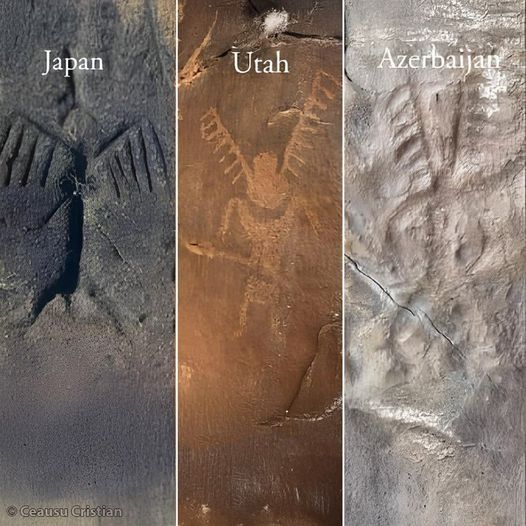In the quiet echoes of stone and time, ancient cultures have etched into the earth a recurring and enigmatic symbol that transcends geographical boundaries: winged human figures. Found in diverse locations such as Japan, Utah, and Azerbaijan, these mysterious petroglyphs weave a narrative far more intricate than simple artistic expression, offering a glimpse into the collective spiritual yearnings of humanity.
Unveiling the Winged Messengers
Ancient civilizations often used art as a bridge between the mundane and the divine. These winged figures, scattered across continents, represent a shared human desire to transcend earthly limitations and connect with the celestial. Each site where these symbols are discovered tells a unique chapter of this interconnected story, revealing a tapestry of spiritual exploration and cultural expression.
Japan’s Fugoppe Cave: Spiritual Whispers from the Jōmon Period
Nestled in the depths of Fugoppe Cave, dating back 7,000 years, lies a gallery of anthropomorphic figures with wings. These carvings, created during the Jōmon period, are more than mere decorations; they serve as windows into the spiritual lives of the ancient Japanese. The winged beings depicted here embody humanity’s primal dream of flight and a connection to realms beyond the physical. This yearning for transcendence reflects a deep-seated human aspiration—to break free from the bounds of earthly existence and touch the divine.

Utah’s Nine Mile Canyon: A Celestial Gallery
Dubbed the “world’s longest art gallery,” Nine Mile Canyon in Utah is adorned with rock art that spans centuries. Created between 950 and 1250 AD by the Fremont and Ute cultures, the winged figures carved into the canyon walls serve as celestial ambassadors, bridging the earthly and the divine. These carvings offer insights into indigenous cosmology, where wings symbolize transcendence and spiritual connection. The canyon’s petroglyphs speak of a profound relationship between humanity and the cosmos, showcasing the role of art in exploring and expressing these bonds.
Azerbaijan’s Gobustan: Crossroads of Ancient Symbolism
At Gobustan, a UNESCO World Heritage site in Azerbaijan, petroglyphs dating back as far as 10,000 years reveal winged human forms. Situated near ancient trade routes, this site likely served as a cultural crucible where ideas and artistic motifs converged. The winged figures here may be linked to shamanistic practices, blurring the lines between the human and the supernatural. Gobustan’s petroglyphs highlight the interconnectedness of ancient civilizations and their shared fascination with the spiritual and the transcendent.
The Profound Questions Behind the Symbols
How did such similar symbols emerge across cultures separated by vast distances and different epochs? Two compelling theories offer potential explanations for this phenomenon.
The first theory is rooted in the universal human experience. Wings, often associated with freedom and divine connection, have inspired myths and legends for millennia. Birds, as masters of flight, naturally became symbols of celestial messengers. This theory suggests that winged figures may have independently arisen from a shared human imagination, reflecting our innate desire to understand the divine and transcend earthly limitations.
The second theory posits cultural diffusion as the driving force behind these similarities. Ancient trade routes, migrations, and shared oral traditions could have facilitated the exchange of symbolic motifs, allowing ideas to travel and evolve across different societies. These interactions may have given rise to the recurring presence of winged human figures in distant lands.
A Glimpse into Shared Human Consciousness
Regardless of their origins, these petroglyphs challenge the notion of ancient civilizations as isolated entities. Instead, they hint at a profound, shared human yearning to understand our place in the cosmos and imagine powers beyond our immediate comprehension. These symbols serve as a testament to humanity’s collective creativity and spiritual curiosity, reminding us of the universal connections that bind us across time and space.
Looking Forward: The Path of Discovery
Advancements in archaeological research promise to shed more light on the mysteries of these winged figures. Comparative studies, advanced dating techniques, and detailed surveys of petroglyph sites will help unravel the complex narratives behind these symbols. Are they evidence of early global exchanges, or do they represent a universal thread of human spirituality that emerged independently in different cultures? Future discoveries will continue to deepen our understanding of these enigmatic carvings and the civilizations that created them.
Conclusion: Echoes Across Time
These ancient artworks are more than historical artifacts; they are mirrors reflecting humanity’s eternal quest for understanding, transcendence, and connection with something greater than ourselves. The winged human figures carved into stone across continents remind us of our shared history and collective imagination. They speak of a timeless desire to bridge the earthly and the divine, to soar beyond the limits of our physical existence, and to find meaning in the vastness of the cosmos. Through these petroglyphs, the whispers of ancient civilizations continue to resonate, inspiring us to explore the mysteries of our past and our enduring spiritual aspirations.





